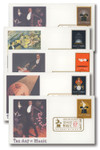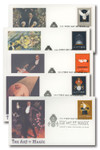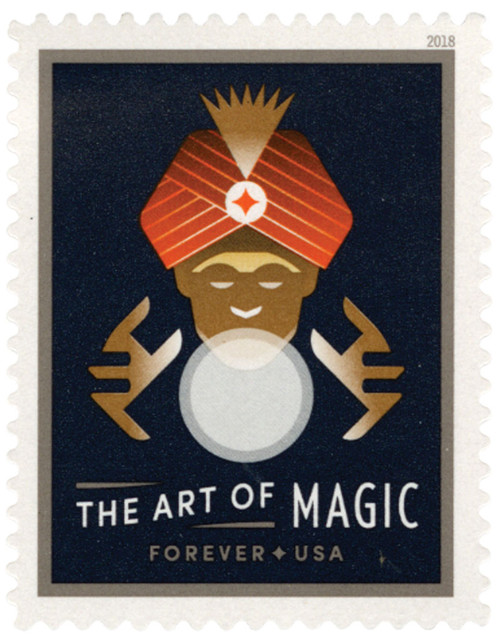
# 5301-05 - 2018 First-Class Forever Stamp - The Art of Magic
U.S. #5301-05
2018 50¢ The Art of Magic
Magic and illusion have been entertaining audiences for hundreds of years. The art form has come a long way since the beginning, with ever more impressive illusions being developed as time goes on. Between the elaborate tricks and theatrical flair of the magicians, modern audiences cannot get enough. In fact, some of the most popular shows in Las Vegas feature magicians.
What keeps people coming back to magic shows again and again is the desire to figure out how a trick is done. Whether it is how a rabbit was pulled out of a seemingly empty hat, or how a pair of gloves was transformed into a live dove, each person in the audience tries to discover how the magician did it. The more elaborate the trick, the more amazed the audience is. Happy audiences return for shows over and over again. This is the very important reason why magicians are said to never reveal their secrets.
In 2018, Las Vegas hosted over a dozen magicians, including the famous David Copperfield, Penn and Teller, and winner of season nine of America’s Got Talent, Mat Franco. Each show brought a different style to the art of magic, whether it was escape tricks, sleight of hand, comedy, or mind-reading. They kept audiences on the edge of their seats and regularly changed up routines to keep things fresh. It is this continued innovation and creativity that keeps magic at the top of the list as one of America’s favorite forms of entertainment.
Harry Houdini was born Erik Weisz on March 24, 1874, in Budapest, Austria-Hungary. He became one of the world’s most famous illusionists, most well-known for his daring escape acts. The Weisz family moved to Appleton, Wisconsin in 1878, where his father was a Rabbi of the Zion Reform Jewish Congregation. After his father lost his job, the family moved the Milwaukee and later New York City. Young Ehrich (he changed his name to the German spelling upon arriving in America) worked a variety of jobs to help support the family. When he was nine, he started working as a trapeze artist, calling himself “Ehrich, the Prince of the Air.” He was also an accomplished cross-country runner. In his teens, Ehrich learned magic from magician Joseph Rinn. He also adopted the name Harry Houdini after two magicians he admired – Jean-Eugène Robert-Houdin and Harry Kellar. Houdini began performing magic publicly in 1891. He put on his act in dime museums and sideshows and was a part-time “Wild Man” at a circus. Early on Houdini mostly performed card tricks, calling himself the “King of Cards,” but he soon turned his focus to escape acts. For several years he performed with his brother Dash as his assistant. Once he met and married, his wife Bess served as his assistant. He got his big break in 1899, when manager Martin Beck. Beck told him to focus on his escape acts and soon got him high-profile vaudeville bookings. Houdini went to Europe in 1900 and his handcuff escape baffled police and got him a six-month booking in London. Between 1900 and 1920, Houdini performed throughout Great Britain and also toured the Netherlands, Germany, France, and Russia. He was dubbed “The Handcuff King,” challenging local police to restrain him and lock him in their jail cells. While back in America, he bought his family a house and briefly had his own magazine, the Conjurers’ Monthly Magazine. He was famous across the country for his feats – freeing himself from handcuffs, chains, ropes, straitjackets and jail cells. When others began to copy his handcuff act, Houdini began escaping from milk cans filled with water. He also invited the public to create their own devices for him to escape from. These included packing crates, beer barrels, boilers, mail bags, and a whale that had washed ashore. Houdini introduced his Chinese Water Torture Cell in 1912. In this illusion, he was hung upside down in a locked glass and steel cabinet filled with water. He had to hold his breath for over three minutes before escaping. Houdini eventually became the highest paid performer in vaudeville in America. In addition to his escape stunts, he famously made an elephant disappear. Houdini served as president of Martinka & Co., the country’s oldest magic company and was president of the Society of American Magicians. Houdini also wrote a few books for magicians that explained how he did some of his tricks. He also spent a few years acting and performing his feats in movies but returned to live shows. In 1925, Houdini began putting on full-evening shows that he billed as “Three Shows in One: Magic, Escapes, and Fraud Mediums Exposed.” Houdini died on October 31, 1926 from a ruptured appendix. It’s been suggested his ruptured appendix was caused by an incident a few nights before. A young man asked Houdini if it was true that punches didn’t hurt his stomach, and repeatedly punched him hard to test the theory. Houdini didn’t get a chance to prepare for the punches and eventually asked the man to stop. He suffered intense pain and high fever over the next few days, ignoring doctors’ recommendations for surgery. His insurance company ultimately believed the punches had been the cause of his death. Today there are at least three Houdini Museums. The Houdini Museum in Scranton, Pennsylvania claims to be “the only building in the world entirely dedicated to Houdini.” The House of Houdini in Budapest claims to have the largest collection of Houdini items. There’s also a Houdini Museum in New York that has a number of Houdini artifacts.Birth of Harry Houdini
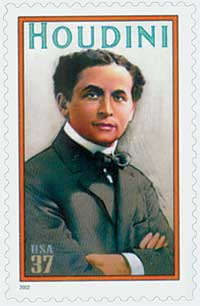
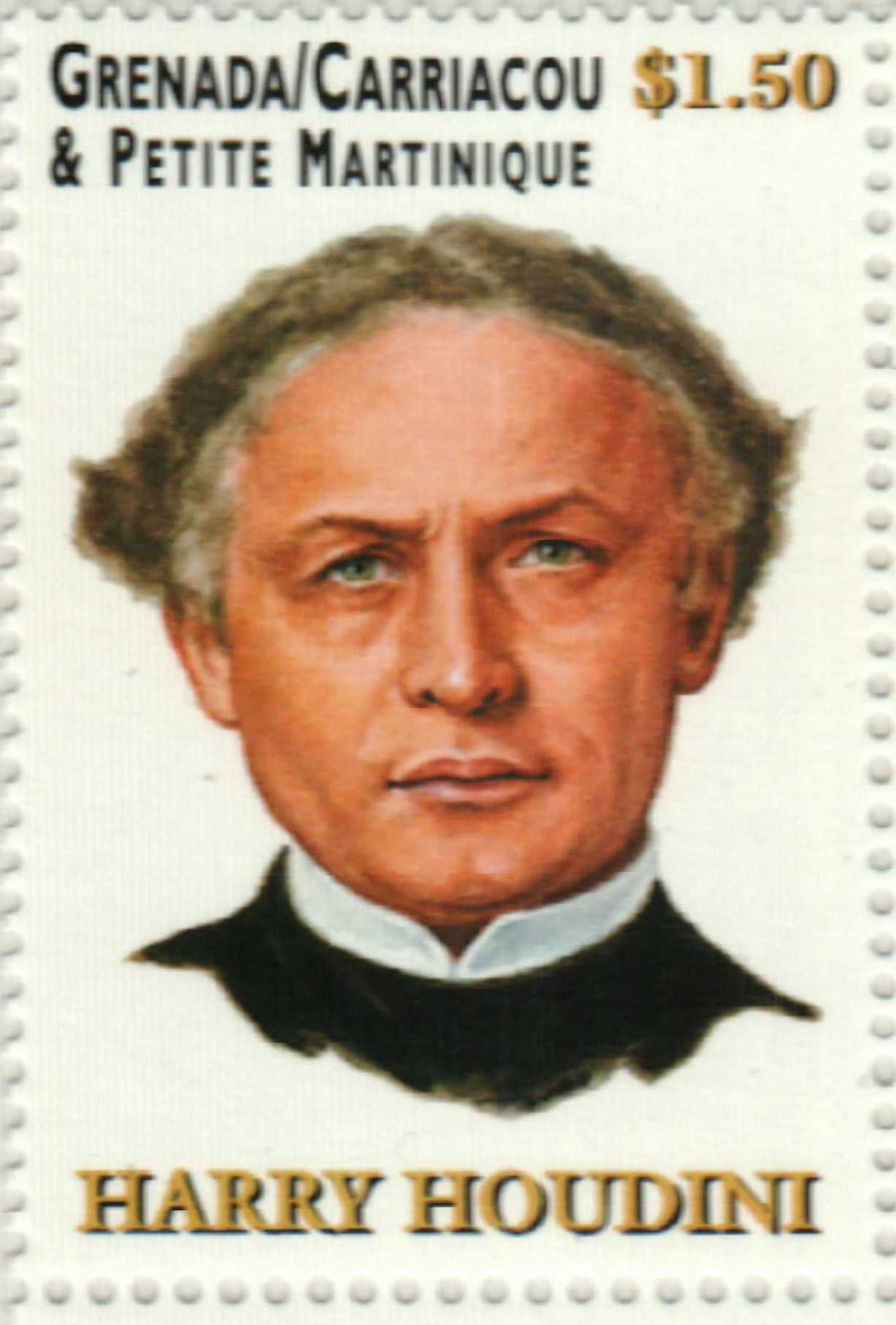

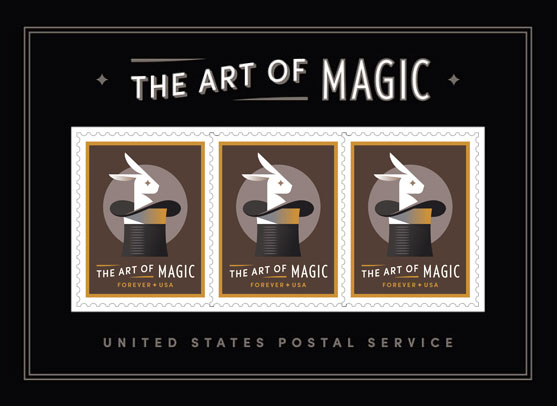


U.S. #5301-05
2018 50¢ The Art of Magic
Magic and illusion have been entertaining audiences for hundreds of years. The art form has come a long way since the beginning, with ever more impressive illusions being developed as time goes on. Between the elaborate tricks and theatrical flair of the magicians, modern audiences cannot get enough. In fact, some of the most popular shows in Las Vegas feature magicians.
What keeps people coming back to magic shows again and again is the desire to figure out how a trick is done. Whether it is how a rabbit was pulled out of a seemingly empty hat, or how a pair of gloves was transformed into a live dove, each person in the audience tries to discover how the magician did it. The more elaborate the trick, the more amazed the audience is. Happy audiences return for shows over and over again. This is the very important reason why magicians are said to never reveal their secrets.
In 2018, Las Vegas hosted over a dozen magicians, including the famous David Copperfield, Penn and Teller, and winner of season nine of America’s Got Talent, Mat Franco. Each show brought a different style to the art of magic, whether it was escape tricks, sleight of hand, comedy, or mind-reading. They kept audiences on the edge of their seats and regularly changed up routines to keep things fresh. It is this continued innovation and creativity that keeps magic at the top of the list as one of America’s favorite forms of entertainment.
Harry Houdini was born Erik Weisz on March 24, 1874, in Budapest, Austria-Hungary. He became one of the world’s most famous illusionists, most well-known for his daring escape acts. The Weisz family moved to Appleton, Wisconsin in 1878, where his father was a Rabbi of the Zion Reform Jewish Congregation. After his father lost his job, the family moved the Milwaukee and later New York City. Young Ehrich (he changed his name to the German spelling upon arriving in America) worked a variety of jobs to help support the family. When he was nine, he started working as a trapeze artist, calling himself “Ehrich, the Prince of the Air.” He was also an accomplished cross-country runner. In his teens, Ehrich learned magic from magician Joseph Rinn. He also adopted the name Harry Houdini after two magicians he admired – Jean-Eugène Robert-Houdin and Harry Kellar. Houdini began performing magic publicly in 1891. He put on his act in dime museums and sideshows and was a part-time “Wild Man” at a circus. Early on Houdini mostly performed card tricks, calling himself the “King of Cards,” but he soon turned his focus to escape acts. For several years he performed with his brother Dash as his assistant. Once he met and married, his wife Bess served as his assistant. He got his big break in 1899, when manager Martin Beck. Beck told him to focus on his escape acts and soon got him high-profile vaudeville bookings. Houdini went to Europe in 1900 and his handcuff escape baffled police and got him a six-month booking in London. Between 1900 and 1920, Houdini performed throughout Great Britain and also toured the Netherlands, Germany, France, and Russia. He was dubbed “The Handcuff King,” challenging local police to restrain him and lock him in their jail cells. While back in America, he bought his family a house and briefly had his own magazine, the Conjurers’ Monthly Magazine. He was famous across the country for his feats – freeing himself from handcuffs, chains, ropes, straitjackets and jail cells. When others began to copy his handcuff act, Houdini began escaping from milk cans filled with water. He also invited the public to create their own devices for him to escape from. These included packing crates, beer barrels, boilers, mail bags, and a whale that had washed ashore. Houdini introduced his Chinese Water Torture Cell in 1912. In this illusion, he was hung upside down in a locked glass and steel cabinet filled with water. He had to hold his breath for over three minutes before escaping. Houdini eventually became the highest paid performer in vaudeville in America. In addition to his escape stunts, he famously made an elephant disappear. Houdini served as president of Martinka & Co., the country’s oldest magic company and was president of the Society of American Magicians. Houdini also wrote a few books for magicians that explained how he did some of his tricks. He also spent a few years acting and performing his feats in movies but returned to live shows. In 1925, Houdini began putting on full-evening shows that he billed as “Three Shows in One: Magic, Escapes, and Fraud Mediums Exposed.” Houdini died on October 31, 1926 from a ruptured appendix. It’s been suggested his ruptured appendix was caused by an incident a few nights before. A young man asked Houdini if it was true that punches didn’t hurt his stomach, and repeatedly punched him hard to test the theory. Houdini didn’t get a chance to prepare for the punches and eventually asked the man to stop. He suffered intense pain and high fever over the next few days, ignoring doctors’ recommendations for surgery. His insurance company ultimately believed the punches had been the cause of his death. Today there are at least three Houdini Museums. The Houdini Museum in Scranton, Pennsylvania claims to be “the only building in the world entirely dedicated to Houdini.” The House of Houdini in Budapest claims to have the largest collection of Houdini items. There’s also a Houdini Museum in New York that has a number of Houdini artifacts.Birth of Harry Houdini











